“How was your hike?” The teachers I passed on the way down from Santa Maria Volcano asked as they went up.
“We all survived!” And that’s how my hike went.
The teacher for the 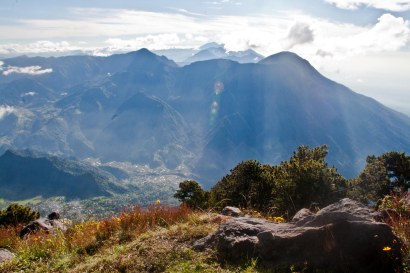 community service class for the high-school students at IAS set up a hike to the top of Santa Maria, a volcano with an elevation of 12,375 feet, to pick up trash along the way. Dr. Fox, the science teacher, offered to take a group of teachers the night before the Saturday morning hike to spend the night at the summit and see the sunrise from above the clouds.
community service class for the high-school students at IAS set up a hike to the top of Santa Maria, a volcano with an elevation of 12,375 feet, to pick up trash along the way. Dr. Fox, the science teacher, offered to take a group of teachers the night before the Saturday morning hike to spend the night at the summit and see the sunrise from above the clouds.
The other five teachers that agreed to such a venture, Dr. Fox and I were hauled in the back of a pickup to the base of the trail to Santa Maria. The dirt road we had been driving on narrowed to a cow path and the houses disappeared for corn fields. Molly went over her first-aid book as we drove from school, and by the time we disembarked from the pickup, we knew theoretically how to diagnose hypothermia and elevation sickness—although we wondered at what point we should be worried, because we were sure we would all have “unusual fatigue, racing heart and shortness of breath” after climbing a mountain. About that, we were right.
As we started up, ladies in skirts and sandals came down the trail in front of me driving cattle, and men followed horses with stacks of firewood tied on their backs. Over my shoulder, Xela sat cupped by mountains. The cornfields ended at a meadow, and so did the (relatively) easy walking. When I was informed that the past hour and a half had been the easy part, I was tempted to turn around and go back to my own bed. I wondered breathlessly what I had gotten myself into.
At the meadow, Dr. Fox handed out flashlights and it started raining. The moon was nearly full, but the clouds blocked it out most of the time, and the rest of the hike was in the darkness of mist and moonlight as we went up into the clouds. There were times when the clouds would roll away at just the right time and the lights of Xela were visible from a switchback. The trail was slick with mud and at places it turned into a nearly hand-over-hand scramble up wet boulders. There were trees that had fallen over the path to duck under and roots like stairs we had to climb up. The clouds were thick and by the time Katie, Kyle and I were climbing in them, it was cold. We could see the mist in front of our flashlights and our breath in puffs. Our sweat was now chilling and we put on coats and hats and gloves. Condensation fell like rain from the large canopied trees, which changed to thin pine trees as we went higher. The rocks grew bigger. The trail grew harder. The moon was not quite full, but gave pale light to the mist as we climbed. When the trees didn’t cover the trail, I could see Katie ahead of me and Kyle behind me without the flashlight. Parts of the trail had washed away to a thin ribbon of slick mud giving way to a ravine that we had to carefully maneuver over. We looked up into the misty horizon and found all at once there were no more trees. There were huge boulders and nothing more. “Dare we hope this is the top?” I asked, as we had hoped before only to be disappointed and the disappointment to our weary bones was worse than the hope.
“I think it is!” Katie agreed, and it was. The volcano ended in giant rocks and gusty wind and nothing more.
My muscles were sore and I was cold. We went by a herd of free-range cattle with tinkling cowbells sleeping and chewing their cud near the edge of the summit. The wind was nipping and we passed over the pinnacle and to the other side of the mountain where the wind was blocked by boulders. There we waited for Molly and Bek and Malinda. They arrived fifteen minutes later and we changed from our sweat-soaked and cold clothes to dry and warmer clothes. It was moments of freezing exposure as we took off our wet clothes, but we all felt better to be dry. Dr. Fox arrived an hour and a half later and we set up the tents and unpacked sleeping bags. After a dinner of peanut butter sandwiches and Gatorade, we all settled in for a freezing night on the hard, cold ground.
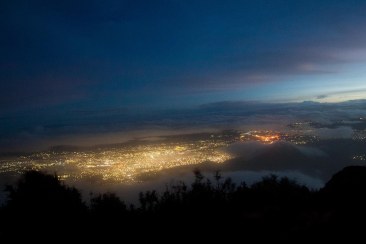 I took my Thankful Journal with me on the hike (the school handed out pocket-sized notebooks to write things we were thankful for this month). I had visions of sitting on the mountaintop like an Instagram photo: the sun rising, pen in hand, blanket draped over my shoulders, vistas of grandeur dropping away before me and beautiful words of thankfulness inspired by the breathtaking and happy view flowing effortlessly from my pen onto my little notebook. Instead, I wrote that night in the dark of my tent huddled shivering in my sleeping bag, one hand shakily holding the pen, the other holding the flashlight as I wrote, “I’m thankful I made it up Santa Maria alive.” Truer sentiments of gratitude I am sure have never been uttered.
I took my Thankful Journal with me on the hike (the school handed out pocket-sized notebooks to write things we were thankful for this month). I had visions of sitting on the mountaintop like an Instagram photo: the sun rising, pen in hand, blanket draped over my shoulders, vistas of grandeur dropping away before me and beautiful words of thankfulness inspired by the breathtaking and happy view flowing effortlessly from my pen onto my little notebook. Instead, I wrote that night in the dark of my tent huddled shivering in my sleeping bag, one hand shakily holding the pen, the other holding the flashlight as I wrote, “I’m thankful I made it up Santa Maria alive.” Truer sentiments of gratitude I am sure have never been uttered.
The light from the nearly full moon made it seem like there was a lamppost outside our tent. I shivered inside my sleeping bag, pulling my coat hood over the hat and earmuffs I was already wearing. I tried to shut my eyes and think of fireplaces and hot chocolate, but I opened them wide when I heard bells.
There are not supposed to be bells at three thirty in the morning at twelve thousand feet up on top of a volcano.
The pounding of feet reverberated through the hard rocks I was trying to sleep on. A dark shadow crossed in front of the moon and stopped in front of the tent door. Two small horns and the large ears of a cow were fully outlined on the door as it sniffed our tent.
I immediately thought of what our cattle at home would do. It will knock our tent down from curiosity and probably step on us while doing it, I thought. It’s what I was sure any nosy cow would do.
To the side, I heard chomping and plastic being rustled, and a sound I was sure was a cow-tongue being scraped over backpacks. I imaged the cows ruining my new backpack and unzipped my sleeping bag. The cold was like a tangible thing and I was enveloped in shivers. I tried unsuccessfully to maneuver so I didn’t wake anyone else up and put on my wet shoes.
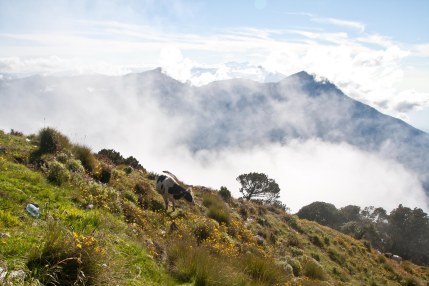 The cows were surrounding the pile of backpacks like conspirators, Katie’s bag of bread in the middle. I just assumed that with deafening cow-bells hanging around their necks, they couldn’t be anything but gentle, and waded among them, shooing left and right. Two scattered down the mountainside where they should have been in the first place amid the boulders and bushes, but the other jumped behind me and stood looking smug between the two tents of sleeping teachers. I am sure had anyone been watching, it would have looked like a circus act as I chased the cow around the tents, with him always just a few steps ahead and determined not to go down the mountain. He made a loop around the backpacks, and around we went like a merry-go-round until he ran down the mountain. My lungs were freezing as I took my shoes off and crawled back in the tent.
The cows were surrounding the pile of backpacks like conspirators, Katie’s bag of bread in the middle. I just assumed that with deafening cow-bells hanging around their necks, they couldn’t be anything but gentle, and waded among them, shooing left and right. Two scattered down the mountainside where they should have been in the first place amid the boulders and bushes, but the other jumped behind me and stood looking smug between the two tents of sleeping teachers. I am sure had anyone been watching, it would have looked like a circus act as I chased the cow around the tents, with him always just a few steps ahead and determined not to go down the mountain. He made a loop around the backpacks, and around we went like a merry-go-round until he ran down the mountain. My lungs were freezing as I took my shoes off and crawled back in the tent.
The other teachers were laughing hysterically at my antics. I pulled the sleeping bag to my chin and tried to warm up. Even with thermal long underwear, leggings, my hiking pants, wool socks, a thermal shirt, a sweater, a coat, a hat, ear muffs, a scarf and gloves, I was cold.
I had just closed my eyes and was listening to the deep breathing of Malinda and Bek when I heard the cowbells again. The cow’s hooves echoed as they trampled over boulders and back to the packs.
I unzipped my sleeping bag with a vengeance and didn’t even put my shoes on as I grabbed Molly’s walking stick (an old and, as I found out, not very sturdy broom handle) and started chasing the cows in wool socks. This time they didn’t scatter, and I put my shoes on as they fell on the backpacks again.
With the wrath of being forced out of what little warmth there was to be had in my sleeping bag for stubborn cows eating my friend’s bread and walking on my new backpack, I went to whacking the cows that were closest. One cow didn’t think I was serious and I broke Molly’s stick over his rump when he wouldn’t move away from the bread. I herded them down the mountain and over boulders and got burs in my hair until they were nearly to the other side of the summit and I hoped they wouldn’t think it was worth it to come back for bread. Katie’s jacket was filthy where the cows had licked it and her bread bag had holes in it. I moved the bread and rearranged the packs and crawled back in the tent for what little sleep there was to be had before the alarm went off at 5:30am to see the sunrise.
The next morning I explained to Molly how her walking stick came to be broken: “Yes, it was the cows, but not in the way you are probably imagining…”
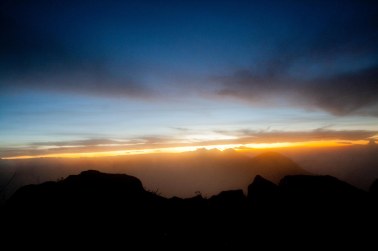 The sunrise was worth battling range-cattle and shivering all night for. Volcanoes stretched from Santa Maria to Lake Atitlan, sixty miles away. The clouds would blow in and out below me as far as I could see, obscuring and revealing the surrounding cities of glowing lights.
The sunrise was worth battling range-cattle and shivering all night for. Volcanoes stretched from Santa Maria to Lake Atitlan, sixty miles away. The clouds would blow in and out below me as far as I could see, obscuring and revealing the surrounding cities of glowing lights.
The view was breathtaking.
After watching the sun rise, we four girls got back in the tent, unzipped our sleeping bags and piled them on top of us and all snuggled under them for another few hours until breakfast, when Dr. Fox handed us pork he had warmed on his stove. We didn’t even get out of our warm bed. My feet tingled as they thawed out. It was the first time all night any of us had been warm.
The morning crispness was intoxicating once I made it out of the tent at seven-thirty. It also might have been the elevation. I was delighted to have climbed to the top, made it through the night, and now to be surrounded by mountains for miles.
Then we headed down the mountain and my delight quickly dissolved. It was slick and slow going. The muscles I had just thought were feeling good began to ache. My knees ached and my ankles ached. I got blisters on my feet and my toes hurt from being jammed in the front of my shoes as I went down. It took us just as long to get down as it did to get up. We passed the crew of students and teachers with the community service group as they climbed to the top, and got trash bags to gather trash on our way down. We picked up the trash that was about shoulder level so we wouldn’t have to bend down for fear of tumbling over from the weight of our packs. We stopped on at the same meadow where we had gotten out our flashlight the night before and had lunch. Everyone stretched out and enjoyed the sunshine and the rest for about twenty minutes before we ambled on towards the very bottom. Katie and I walked very slowly, taking small steps and many breaks to rest our knees and feet. It rained a bit and made things even slicker.
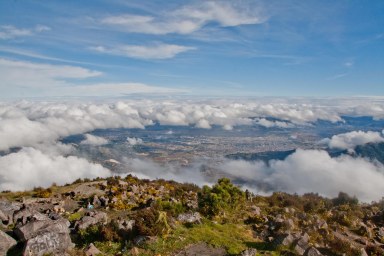 When we finally made it down, Dr. Fox bought us drinks from a little tienda, and a dad of one of the IAS student’s gave us a ride to Calvario. It was about 3:30 in the afternoon when I arrived home. I slept the rest of the afternoon and didn’t unpack my backpack until Wednesday.
When we finally made it down, Dr. Fox bought us drinks from a little tienda, and a dad of one of the IAS student’s gave us a ride to Calvario. It was about 3:30 in the afternoon when I arrived home. I slept the rest of the afternoon and didn’t unpack my backpack until Wednesday.
Yet, for all that, it was worth the aching muscles and the cold and the cows to climb the volcano. As Molly kept saying, “Choose adventure.” And I am glad I did.

I love to read your writings….they are so descriptive and I was cold and exhausted with you as “we” climbed that mountain, Great experiences!
LikeLike
Hi! WOW. What an experience! I hope you’re never that cold, wet, and tired again, but I’m sure those discomforts will help you NEVER forget what you felt and thought and saw on your adventure. I loved the beautiful pics – such gorgeous vistas! Thank you for sharing them so I don’t have to make that trek! I look forward to seeing and hugging you next month!
LikeLike